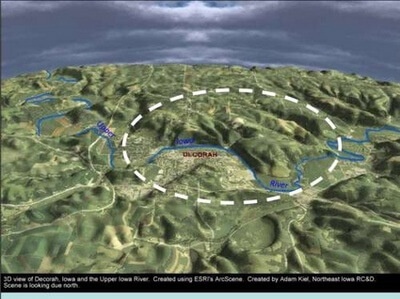
Next question for geologists: "How deep is the Decorah Crater?"
In 2008-09, geologists from the Iowa Geological and Water Survey hypothesized about the existence of the "Decorah Impact Structure." Not quite five years later, aerial surveys conducted by the U.S. Geological Survey in cooperation with the Iowa and Minnesota Geological Surveys confirmed the existence of proof of an ancient meteorite impact on Decorah.
More than ten years after the "Decorah Impact Structure" was predicted, two of the geologists who did that research--Bob McKay and Paul Liu of the Iowa Geological Survey--returned to Decorah this week. The two are recently retired from their jobs, but they're still excited about the project they've worked on for almost 20 years.
McKay says rocks found in core drillings showed fractures--a sign of stress from the impact of a meteorite. He says their theory is also supported by the fact that "a cluster of structures" was created at the same time in the 3.5 mile circle that includes more than half of the City of Decorah.
Liu is excited by core samples from well drillings which have produced "well-preserved fossil specimens." "More and more fossils are coming up," he says--including many fossils in new type categories
So what will be the next area of focus for the research on the Decorah crater? Both men agree they'd like to see research on how deep the crater goes, as well as research on the material which filled in the crater after it was created. Liu says fill materials found in the crater hole might help geologists reconstruct conditions going as far back as 20 million years.
Site designed and maintained by Iroc Web Design Services©.
Your Small Business Web Design Solutions.™


